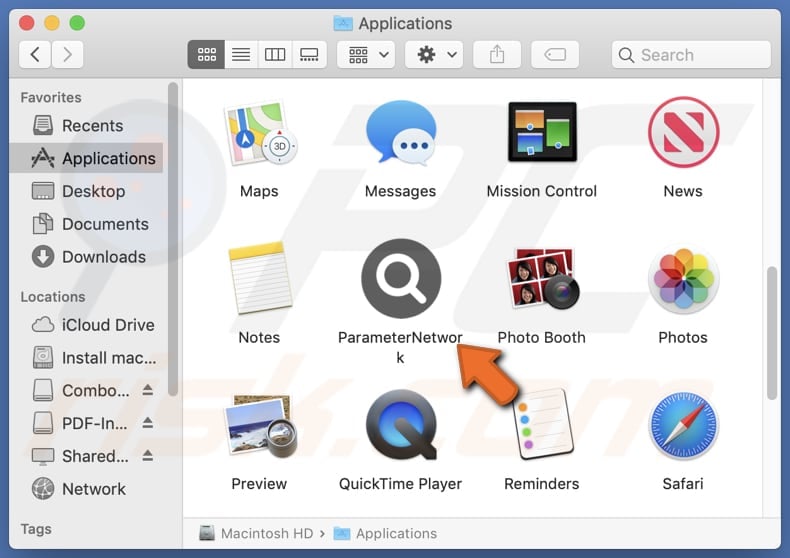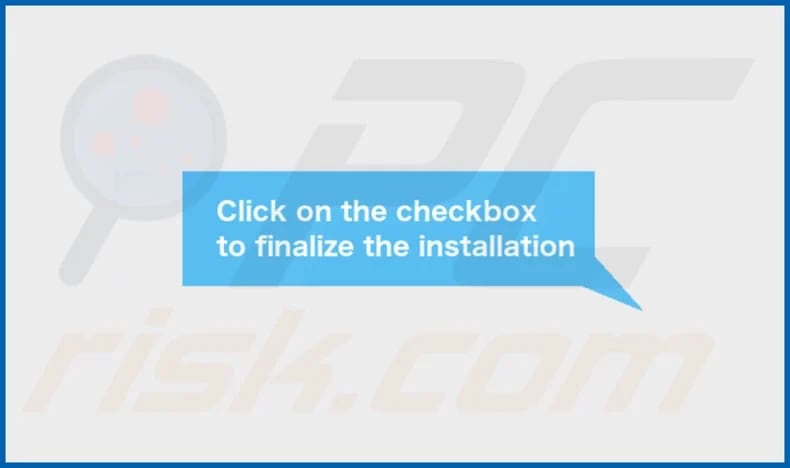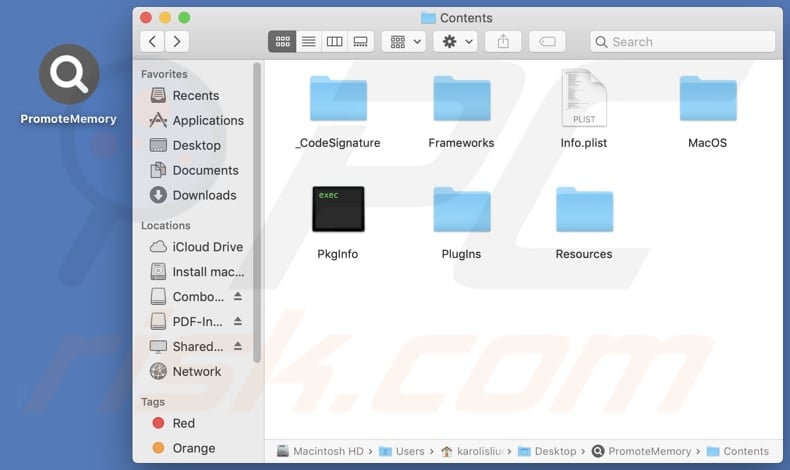Get free scan and check if your device is infected.
Remove it nowTo use full-featured product, you have to purchase a license for Combo Cleaner. Seven days free trial available. Combo Cleaner is owned and operated by RCS LT, the parent company of PCRisk.com.
What is ParameterNetwork?
Upon inspecting ParameterNetwork, we found that it is designed to generate various intrusive advertisements. Thus, we classified ParameterNetwork as adware. It is common for software of this type to be promoted as useful without mentioning that it delivers ads. Users should avoid installing apps like ParameterNetwork.

ParameterNetwork adware in detail
ParameterNetwork can display various types of ads, including pop-ups, banners, coupons, and in-text ads. These advertisements often promote dubious products, websites, or services and can be intrusive and disruptive to the user experience. Clicking such ads can lead to websites hosting other unwanted apps, including browser hijackers or even malware.
Also, ads from ParameterNetwork may lead users to phishing sites, technical support scams, fake giveaways, lotteries, surveys, etc. Users might be lured into disclosing credit card details, passwords, social security numbers, ID card information, or other details. Also, they may be tricked into paying for fake services or products or sending scammers money.
Thus, trusting ads from ParameterNetwork could result in identity theft, financial losses, unwanted installations, computer infections, and other issues. In addition to displaying ads, ParameterNetwork might gather various data, like IP addresses, geolocation information, browsing history, and similar details.
In some cases, apps like ParameterNetwork can access passwords, credit card details, and other sensitive information that can be misused for malicious purposes. Moreover, ParameterNetwork likely consumes system resources, slowing down a computer. Overall, it is not recommended to trust ParameterNetwork.
| Name | Ads by ParameterNetwork |
| Threat Type | Adware, Mac malware, Mac virus |
| Detection Names | Avast (MacOS:AdAgent-L [Adw]), Combo Cleaner (Gen:Variant.Adware.MAC.Adload.17), ESET-NOD32 (A Variant Of OSX/Adware.Synataeb.H), Kaspersky (Not-a-virus:HEUR:AdWare.OSX.Adload.j), Full List (VirusTotal) |
| Additional Information | This application belongs to Adload malware family. |
| Symptoms | Your Mac becomes slower than normal, you see unwanted pop-up ads, you are redirected to dubious websites. |
| Distribution methods | Deceptive pop-up ads, free software installers (bundling), torrent file downloads. |
| Damage | Internet browser tracking (potential privacy issues), display of unwanted ads, redirects to dubious websites, loss of private information. |
| Malware Removal (Windows) |
To eliminate possible malware infections, scan your computer with legitimate antivirus software. Our security researchers recommend using Combo Cleaner. Download Combo CleanerTo use full-featured product, you have to purchase a license for Combo Cleaner. 7 days free trial available. Combo Cleaner is owned and operated by RCS LT, the parent company of PCRisk.com. |
Conclusion
In conclusion, adware is software that generates intrusive advertisements, compromising user experience and privacy. It can slow down system performance and pose security risks by tracking online activities and redirecting users to potentially harmful websites. Users should avoid installing adware.
Some examples of apps similar to the one described in our article are FilterSkill, FunctionGuide, and InterfaceSignal.
How did ParameterNetwork install on my computer?
Users often install adware during installations of other (free or questionable) programs. It happens when users do not deselect adware using the provided settings (e.g., "Advanced" or "Custom") or checkboxes. This distribution method is known as bundling.
Also, users may unknowingly install adware via deceptive advertisements, pop-ups, notifications from untrustworthy websites, ads generated by already installed adware, etc. Additionally, downloading from P2P networks, unofficial app stores or pages, third-party downloaders, and similar sources can lead to adware installation.
How to avoid installation of unwanted applications?
Download programs (and files) from official websites and app stores. Avoid using other sources (examples are provided in the previous paragraph). Always review installers and reject offers to install unwanted apps before finishing software installation (especially if it is free). Do not allow questionable sites to send you notifications.
Also, do not trust advertisements, links, pop-ups, download buttons, and similar content on shady pages. Keep the operating system and all installed programs up to date, and regularly scan your computer for threats. If your computer is already infected with ParameterNetwork, we recommend running a scan with Combo Cleaner Antivirus for Windows to automatically eliminate this adware.
A pop-up that appears after the installation of ParameterNetwork:

ParameterNetwork's installation folder:

Instant automatic malware removal:
Manual threat removal might be a lengthy and complicated process that requires advanced IT skills. Combo Cleaner is a professional automatic malware removal tool that is recommended to get rid of malware. Download it by clicking the button below:
DOWNLOAD Combo CleanerBy downloading any software listed on this website you agree to our Privacy Policy and Terms of Use. To use full-featured product, you have to purchase a license for Combo Cleaner. 7 days free trial available. Combo Cleaner is owned and operated by RCS LT, the parent company of PCRisk.com.
Quick menu:
- What is ParameterNetwork?
- STEP 1. Remove ParameterNetwork related files and folders from OSX.
- STEP 2. Remove ParameterNetwork ads from Safari.
- STEP 3. Remove ParameterNetwork adware from Google Chrome.
- STEP 4. Remove ParameterNetwork ads from Mozilla Firefox.
Video showing how to remove ParameterNetwork adware using Combo Cleaner:
ParameterNetwork adware removal:
Remove ParameterNetwork-related potentially unwanted applications from your "Applications" folder:

Click the Finder icon. In the Finder window, select "Applications". In the applications folder, look for "MPlayerX", "NicePlayer", or other suspicious applications and drag them to the Trash. After removing the potentially unwanted application(s) that cause online ads, scan your Mac for any remaining unwanted components.
DOWNLOAD remover for malware infections
Combo Cleaner checks if your computer is infected with malware. To use full-featured product, you have to purchase a license for Combo Cleaner. 7 days free trial available. Combo Cleaner is owned and operated by RCS LT, the parent company of PCRisk.com.
Remove adware-related files and folders

Click the Finder icon, from the menu bar. Choose Go, and click Go to Folder...
 Check for adware generated files in the /Library/LaunchAgents/ folder:
Check for adware generated files in the /Library/LaunchAgents/ folder:

In the Go to Folder... bar, type: /Library/LaunchAgents/

In the "LaunchAgents" folder, look for any recently-added suspicious files and move them to the Trash. Examples of files generated by adware - "installmac.AppRemoval.plist", "myppes.download.plist", "mykotlerino.ltvbit.plist", "kuklorest.update.plist", etc. Adware commonly installs several files with the exact same string.
 Check for adware generated files in the ~/Library/Application Support/ folder:
Check for adware generated files in the ~/Library/Application Support/ folder:

In the Go to Folder... bar, type: ~/Library/Application Support/

In the "Application Support" folder, look for any recently-added suspicious folders. For example, "MplayerX" or "NicePlayer", and move these folders to the Trash.
 Check for adware generated files in the ~/Library/LaunchAgents/ folder:
Check for adware generated files in the ~/Library/LaunchAgents/ folder:

In the Go to Folder... bar, type: ~/Library/LaunchAgents/

In the "LaunchAgents" folder, look for any recently-added suspicious files and move them to the Trash. Examples of files generated by adware - "installmac.AppRemoval.plist", "myppes.download.plist", "mykotlerino.ltvbit.plist", "kuklorest.update.plist", etc. Adware commonly installs several files with the exact same string.
 Check for adware generated files in the /Library/LaunchDaemons/ folder:
Check for adware generated files in the /Library/LaunchDaemons/ folder:

In the "Go to Folder..." bar, type: /Library/LaunchDaemons/

In the "LaunchDaemons" folder, look for recently-added suspicious files. For example "com.aoudad.net-preferences.plist", "com.myppes.net-preferences.plist", "com.kuklorest.net-preferences.plist", "com.avickUpd.plist", etc., and move them to the Trash.
 Scan your Mac with Combo Cleaner:
Scan your Mac with Combo Cleaner:
If you have followed all the steps correctly, your Mac should be clean of infections. To ensure your system is not infected, run a scan with Combo Cleaner Antivirus. Download it HERE. After downloading the file, double click combocleaner.dmg installer. In the opened window, drag and drop the Combo Cleaner icon on top of the Applications icon. Now open your launchpad and click on the Combo Cleaner icon. Wait until Combo Cleaner updates its virus definition database and click the "Start Combo Scan" button.

Combo Cleaner will scan your Mac for malware infections. If the antivirus scan displays "no threats found" - this means that you can continue with the removal guide; otherwise, it's recommended to remove any found infections before continuing.

After removing files and folders generated by the adware, continue to remove rogue extensions from your Internet browsers.
Remove malicious extensions from Internet browsers
 Remove malicious Safari extensions:
Remove malicious Safari extensions:

Open the Safari browser, from the menu bar, select "Safari" and click "Preferences...".

In the preferences window, select "Extensions" and look for any recently-installed suspicious extensions. When located, click the "Uninstall" button next to it/them. Note that you can safely uninstall all extensions from your Safari browser - none are crucial for regular browser operation.
- If you continue to have problems with browser redirects and unwanted advertisements - Reset Safari.
 Remove malicious extensions from Google Chrome:
Remove malicious extensions from Google Chrome:

Click the Chrome menu icon ![]() (at the top right corner of Google Chrome), select "More Tools" and click "Extensions". Locate all recently-installed suspicious extensions, select these entries and click "Remove".
(at the top right corner of Google Chrome), select "More Tools" and click "Extensions". Locate all recently-installed suspicious extensions, select these entries and click "Remove".

- If you continue to have problems with browser redirects and unwanted advertisements - Reset Google Chrome.
 Remove malicious extensions from Mozilla Firefox:
Remove malicious extensions from Mozilla Firefox:

Click the Firefox menu ![]() (at the top right corner of the main window) and select "Add-ons and themes". Click "Extensions", in the opened window locate all recently-installed suspicious extensions, click on the three dots and then click "Remove".
(at the top right corner of the main window) and select "Add-ons and themes". Click "Extensions", in the opened window locate all recently-installed suspicious extensions, click on the three dots and then click "Remove".

- If you continue to have problems with browser redirects and unwanted advertisements - Reset Mozilla Firefox.
Frequently Asked Questions (FAQ)
What harm can adware cause?
Adware can compromise privacy by gathering various data. It can also diminish the web browsing experience by generating annoying advertisements. Moreover, software of this type can expose users to security and privacy risks by showing ads designed to open potentially malicious pages. Adware can also slow down computers.
What does adware do?
Usually, adware displays intrusive ads. Sometimes, it can gather various data and hijack web browsers.
How do adware developers generate revenue?
Adware developers typically generate revenue by promoting various products, websites, or services through intrusive advertisements. Most of their income is derived from affiliate programs, where they earn commissions for driving traffic or sales.
Will Combo Cleaner remove ParameterNetwork adware?
Combo Cleaner scans your computer and removes all installed adware-type applications. However, manual removal is not always ideal. Even after deleting the software, some components could still be present and active. Therefore, it is recommended to use tools like Combo Cleaner to remove adware completely.
Share:

Tomas Meskauskas
Expert security researcher, professional malware analyst
I am passionate about computer security and technology. I have an experience of over 10 years working in various companies related to computer technical issue solving and Internet security. I have been working as an author and editor for pcrisk.com since 2010. Follow me on Twitter and LinkedIn to stay informed about the latest online security threats.
PCrisk security portal is brought by a company RCS LT.
Joined forces of security researchers help educate computer users about the latest online security threats. More information about the company RCS LT.
Our malware removal guides are free. However, if you want to support us you can send us a donation.
DonatePCrisk security portal is brought by a company RCS LT.
Joined forces of security researchers help educate computer users about the latest online security threats. More information about the company RCS LT.
Our malware removal guides are free. However, if you want to support us you can send us a donation.
Donate
▼ Show Discussion